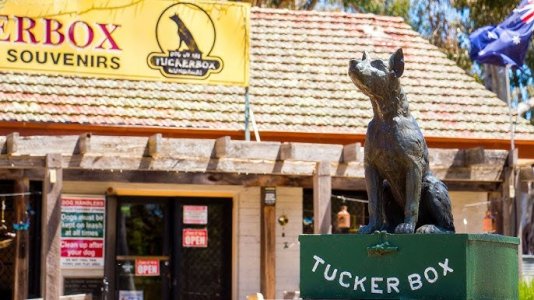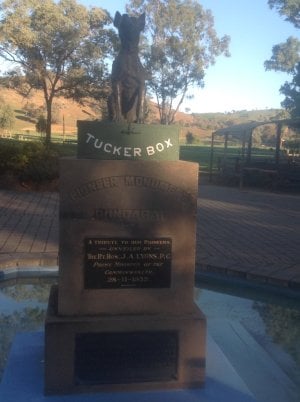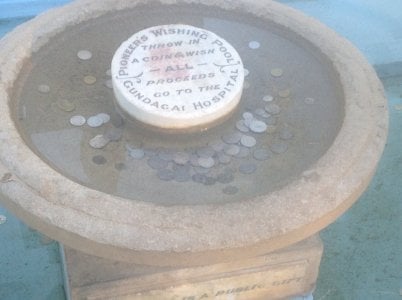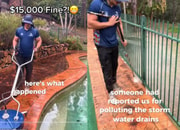The Mystery of the Dog on The Tuckerbox
- Replies 5
Note from the Editor:
This article was kindly written for the SDC by member @Doctor Alan.
Many years ago, in the early 70s, I believe, we went on a driving holiday to Melbourne from Sydney. There were many wonderful little towns to visit along the way, and one of these was Gundagai, where there was a very prominent statue of a dog sitting on some sort of box. The inscription under this included an extract from a poem about a ‘Bullocky’ for whom all sorts of things went wrong, and to cap it all, the dog ‘sat on the tuckerbox’ eight kilometres from Gundagai.
A few years later, I was working for a company based in St Mary’s NSW called ‘Magnetic Analysis Corporation’ (an American company). My job, servicing and repairing eddy-current testing equipment for testing the welds on steel tubing, called for me to make frequent trips to Melbourne and Adelaide. On the trips to Melbourne, if I travelled by car, I would pass through Gundagai, which was conveniently placed for a cup of tea and cake. I would wander around the place for a short break and noticed, at one point, a tea towel with the full poem on it. However, in this poem, the dog didn’t just ‘sit’ on the tuckerbox – it s*** IN the tuckerbox. Now, the poem made far more sense.
When I got back to Sydney, I mentioned this to my ‘boss’, and he was adamant that the ‘vulgar’ version of the poem was ‘lampooning’ the original. I tried to argue that a dog simply ‘sitting’ on a tuckerbox was no threat, and didn’t make a lot of sense, but he wasn’t having any of it. I’ve learnt, over the years in Australia, that there are certain things that are simply not up for discussion. While it’s OK to swear on TV and radio, and a TV personality would certainly not now get the sack for making a ‘crow-call’ that sounds like something else, the thought of an iconic dog doing the dirty into somebody’s lunch is simply not acceptable. I don’t know if that’s duplicity or just plain stupidity.
Of course, at the time, I had no access to the internet, so I trawled the local library for information, just to prove him wrong. It wasn’t easy, but in several hours, I found information that today, only took me a few minutes online.
The ‘original’ poem:
Here is what is thought to be the original poem called ‘Bullocky Bill’, said to have been written by Bowyang Yorke in 1857 (although this date has been disputed); it was published anonymously:
I'm used to punchin' bullock teams across the hills and plains.
I've teamed outback for forty years through bleedin' hail and rain.
I've lived a lot of troubles down without a bloomin' lie,
But I can't forget what happened just five miles from Gundagai.
'Twas getting dark, the team got bogged, the axle snapped in two.
I lost me matches and me pipe, so what was I to do?
The rain it was a-coming on, and hungry too was I,
And me dog shat in me tucker-box five miles from Gundagai.
Some blokes I know have stacks of luck, no matter where they fall,
But there was I, Lord love a duck, no bloody luck at all.
I couldn't heat a pot of tea or keep me trousers dry,
And me dog shat in me tucker-box five miles from Gundagai.
Now, I can forgive the bleedin' team. I can forgive the rain.
I can forgive the damp and cold and go through it again.
I can forgive the rotten luck, but hang me till I die,
I can't forgive that bloody dog five miles from Gundagai.
Well, amongst Gundagai locals, bushmen, and 'those in the know', it is widely understood that the 'real' wording is scatological (relating to excrement or obscenity or having an interest in such things). The Gundagai Independent wrote in 1945: 'Ask almost any youth-about-town about the dog from Gundagai, and you will probably be greeted with a knowing grin that suggests that the subject is not one for polite discussion, and more fit for the shearing shed and the travellers’ campfire. The 'hidden' wording (in published poems) is 'And the dog shat on the tucker box nine miles from Gundagai'; it has even been said by some that that 'the dog shat in the tucker box' (emphasis added). Either way, it makes the story of the poem much more memorable, even though more distasteful (or more humorous, depending on your frame of mind).
The ’sanitised’ version:
In 1923, Jack Moses, a well-known bush poet of the day, wrote a similar poem, and here are the first two verses:
I've done my share of shearing sheep,
Of droving and all that;
And bogged a bullock team as well,
On a Murrumbidgee flat.
I've seen a bullock stretch and strain
And blink his bleary eye
And the Dog sat on the Tuckerbox
Nine miles from Gundagai.
To me, the original poem makes a lot more sense. Also, I think it’s really funny and a very good example of Australian humour. There is a view (shared by my boss all those years ago) that the ‘vulgar’ version was written later, but my research indicates the opposite. Some people hold the view that the dog was trained to ‘guard’ the tuckerbox — if that was the case, why make it out to be such a bad thing in the sanitised version of the poem?
How far from Gundagai?
What’s this about the distance from Gundagai? According to one source, the verse was based upon a true incident that occurred five miles outside of Gundagai at Five Mile Creek (also known as Splitter’s Creek and previously called Sugar O’Brien’s Creek). A bullock driver named Billy Noake was camped at the five-mile point; one of the leading bullocks was stubborn and wouldn’t come up to have a yoke placed upon him, so, in a fit of bad temper, Noake hit the bullock on the head with the yoke, and the misplaced blow smashed the bullock’s eye (presumably, this was an accident; the last thing a bullock-driver needs is to have a bullock with one eye, let alone one in enormous pain); and then, on top of all that, his dog ‘sat’ on his tucker box. A rhyme was subsequently made up about the incident. According to a speech given by a local, Tom Woodbridge, in 1938, the five-mile point (beside the creek) would be the correct location of the incident, as the nine-mile point lacked water and would therefore be an unlikely camping spot; this opinion, regarding the correct camping spot, was confirmed by The Gundagai Independent in 1945.
Further evidence of this is that the first monument to the event was set five miles from Gundagai.
In 1938, Jack Clunes wrote this:
Now, dog on the Tucker-box,
You got us puzzled flat;
They'll hold a Royal Commission yet
To find out where you sat.
Was it at the five mile-
Now tell us, dinky-di
Or was it on the Tucker-box
Nine Miles from Gundagai?
You are holding up the country,
You can't go on doing that,
We want it known, once and for all,
Where the hell you sat.
Was it at the Five Mile?
Don't blink your bleary eye;
Jack Moses said you did the trick,
Nine Miles from Gundagai.
Jack Moses himself insisted that it was supposed to be ‘nine miles’ from Gundagai, not five, although the statue has been positioned right at ‘Five Mile Creek’ (about 8km) north of Gundagai.
I personally think bush poetry — some call it ‘doggerel’ — beats the pants off of some of that they tried to get us to appreciate at school from ‘very well renowned’ poets. Even the great Banjo Paterson wrote a poem called ‘The Road To Gundagai’ — it’s a fascinating and beautiful part of Australia.
A lot of my information for this article has come from this excellent website.
About the author: Having spent three years living in Australia in his youth, Alan returned to Australia in 1969 with his wife and young child. Holding a Bachelor of Engineering degree and a Doctor of Science Education degree, Alan has experience in flight simulations, Einsteinian physics, and inventing an ‘eye blink’ device that allows cerebral palsy patients to communicate. He even took a turn at acting, starring in a TV advert and landing supporting and lead roles in his local dramatic society plays. His short stories have been published in WA’s The Gingin Buzz for ten years, and his novel The Magic Hourglass is a work in progress. He and his wife have a lovely life in Brisbane and regularly visit their two children in Sydney’s West. You can read Alan’s full-length bio here.
Note from the Editor:
Have you heard this poem before? Which version is the ‘true’ one, in your opinion? Perhaps you’ve visited this town and have a photo with the statue. We’d love to see it!
Love Alan’s writing and want to read more? You might also like to read:
Alan G.’s Member Spotlight: ‘Almost Famous’
The Ice Cream Job: The Tech Guy – Dr Al
The Lucky Man: The Tech Guy – Dr Al
‘Ten Pound Pom’ Hostel Living: The Tech Guy – Dr Al
Many Happy Returns of the Day!
Reaching for the Stars!
Sportsmanship, Manners, and Respect
My great-grandfather’s journal of 1908: The Tech Guy – Dr Al
Christmases I’ve Had










